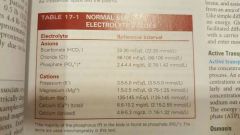![]()
![]()
![]()
Use LEFT and RIGHT arrow keys to navigate between flashcards;
Use UP and DOWN arrow keys to flip the card;
H to show hint;
A reads text to speech;
32 Cards in this Set
- Front
- Back
|
Percent of adult body weight that is water: |
50%-60% |
|
|
Percent of older adults body weight that is water: |
45%-55% |
|
|
Fat to watet content ratio in the body: |
The more fat, the less water |
|
|
The two fluid compartments in the body: |
Intracellular and extracellular |
|
|
Intracellular fluid |
~ 2\3 of the body water that is located within the cells, approximately 40% of body weight in an adult |
|
|
What does extracellular fluid consist of? |
Interstitial fluid, transcellular fluid, and plasma |
|
|
Transcellular fluid consists of: |
Cerebrospinal fluid, fluid in the GI tract, and plural, synovial, peritoneal, intraocular, and pericardial fluid |
|
|
Interstitial fluid |
The fluid in the spaces between cells |
|
|
Percent of the bodys water that is extracellular fluid : |
1/3 |
|
|
How much does one liter of water weigh? |
2.2 lb |
|
|
Electrolytes |
Substances whose molecules disassociate or split into ions when placed in water |
|
|
Ions |
Electrically charged particles |
|
|
Cations |
Positively charged ions; examples include: sodium, potassium, calcium, and magnesium |
|
|
Anions |
Negatively charged ions; examples include: bicarbonate, chloride, and phosphate |
|
|
Normal serum electrolyte levels |

|
|
|
Two forces that move water: |
Hydrostatic pressure & osmotic pressure |
|
|
Water deficit |
Plasma osmolality greater than 295 mOsm/kg |
|
|
Water excess |
Plasma osmolality less than 275 mOsm/kg |
|
|
The two forces that move water: |
Hydrostatic pressure and osmotic pressure |
|
|
Diffusion |
The movement of molecules from an area of high concentration to one of low concentration |
|
|
Facilitated diffusion |
Involves the use of a protein carrier in the cell membrane, is passive and requires no energy. Example: glucose transport |
|
|
Active transport |
A process in which molecules move against the concentration gradient external energy is required for this process. Example : sodium potassium pump |
|
|
Osmolality |
The test typical performed to evaluate the concentration of plasma and urine. Assess the bodys water balance |
|
|
Normal plasma osmolality |
275 - 295 mOsm/kg |
|
|
Urine osmolality |
100 - 1300 mOsm/kg depending on fluid intake and ADH in circulation |
|
|
Hypotonic |
Solutions in which the solutes are less concentrted than in the cells |
|
|
Hypertonic |
Fluids with solutes more concerned than in cells, or increased osmolality |
|
|
Osmotic pressure |
The higher the concentration of a solution, the greater the solutions pulling |
|
|
Oncotic pressure |
Determined greatly by protein. Plasma protein molecules attract water |
|
|
What regulates the thirst mechanism? |
Hypothalamus |
|
|
What are some factors stimulate ADH release? |
Stress, nausea, nicotine, and morphine |
|
|
What is the average adult urinary output per day? |
1.5 L |

